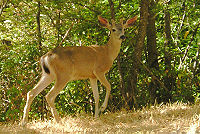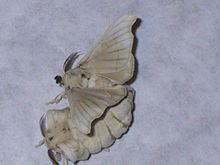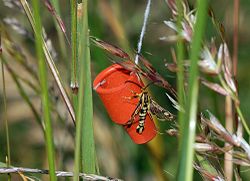Pheromone

Like hormones, pheromones are endogenous (internally produced) chemical signals secreted by multicellular organisms. Whereas hormones affect the behavior and development of the individual that produces them, pheromones trigger an innate response in another member of the same species. Among behaviors influenced by hormones are sexual attraction, territorial demarcation, signaling alarm, and attracting members of a group together for feeding or defense purposes. They are utilized by a wide variety of organisms, including insects, vertebrates, plants, and fungi.
Pheromones belong to a larger class of organic compounds called seriochemicals, which are chemicals involved in animal communication. Pheromones are more specifically used for communication within a species; these signals, which may be secreted by special glands or incorporated into other substances like urine, are picked up by the olfactory systems of the receivers.
One illustration of the ubiquity of pheromones and the interconnectedness of life was the discovery in 1996 that the Asian elephant, one of the largest living animals on land, shares its female sex pheromone with approximately 140 species of moth (Wyatt 2003). Of course, the similarity is unlikely to confuse the moths and elephants when it comes to mating: the elephant compound is not precise enough for male moths (moth pheromones have multiple components), and the moth pheromone is released in amounts too small for male elephants to detect. Nonetheless, the shared use of a compound indicates the independent development of signaling molecules by unrelated species, a relatively common phenomenon that is a consequence of the common origin of life.
In nature, there are no organisms that do not relate with other organisms and the abiotic environment. Pheromones offer one mechanism by which organisms communicate with each other. In some cases, that communication also reflects more than just the survival and reproduction of an individual organism, but also contributing to others beyond self. An example would be the European minnow, which releases an alarm pheromone only when its skin is damaged, warning other minnows of the danger of a predator, or the odor released by the black-tailed deer signaling of danger. Others may use pheromones to attack other members of the species to a food source. Some pheromones help in establishing order, such as marking territories or specialization of tasks in social insects.
Overview
Pheromones may be divided into two broad categories: Releaser pheromones, which typically have immediate effects on the behavior of the receiver, and primer pheromones, which trigger long-term physiological effects. Primer pheromones have a slower onset but longer duration than releaser pheromones. These divisions are not strict, however, as many pheromones can play both roles.
Some of the multitude of behavioral and developmental effects mediated by pheromones include:
- Sexual attraction. Pheromones are involved in various facets of reproduction, from a female signaling her availability for mating to a male advertising his desirable traits in mate selection and sexual competition.
- Territorial demarcation. Some pheromones mark the territory of an animal, particularly among terrestrial vertebrates.
- Signaling danger. Alarm pheromones warn other group members of a nearby predator.
- Recruitment. Pheromones are released to draw group members to new sources of food (common among foragers like ants and termites) or to call them to the defense of the community.
Social insects (a group that includes ants, bees, and some species of wasp and termite) use pheromones to coordinate the activities of the colony. Honeybees, for example, have one of the most complex pheromonal communication systems found in nature, possessing 15 known glands that produce an array of compounds (Blum 1992; Free 1987).
Although the use of pheromones among insects has been particularly well documented, many vertebrates and plants also communicate using pheromones. Pheromones are even used by some fungi, slime molds, and algae in reproduction. Although the presence of pheromones in humans remains undetected, there is a possibility that pheromones play an unconscious role in certain human interactions, given the importance of odor as a signal in many other mammalian species. Demonstrated effects of odors in research on human pheromones include parent-child recognition and menstrual synchrony in cohabitating groups of women. However, firm conclusions on the role (if any) of pheromones in human sexual attraction have proven elusive.
The detection of pheromones
Across the animal kingdom, pheromones are detected by olfactory systems, which have a remarkable degree of similarity. These systems for detecting pheromones and other odors include olfactory sensory neurons (OSNs)‚ÄĒnerve cells with one end exposed to the external environment, often embedded in an otherwise impermeable skin or cuticle. Pheromones are converted into signals by first binding to a receptor protein in the cell membrane of the OSN. This activates a G-protein, triggering a cascade of reactions leading to the transmission of electrical impulses down the axon of the OSN to the brain.
Most amphibians, reptiles, and mammals have a dual olfactory system, which includes the main olfactory epithelium (MOE) and the vomeronasal organ (VNO), also known as "Jacobson's organ." Located between the nose and mouth, the VNO sends signals to an accessory olfactory bulb. Depending on the species, pheromones and other olfactory recognition cues may be detected by the MOE, the VNO, or both systems.
Hormones within the organism also help to orchestrate the appropriate responses to pheromone signals.
Types of pheromones
Pheromones are typically classified by function. The divisions below represent only a sampling of the diverse activities coordinated by pheromones:
Sex pheromones
One of the best-known sex pheromones (and the first pheromone to be characterized) is a polyalcohol called bombykol, which is released by the female silkworm (bombyx mori) to attract mates. The male's antennae are so sensitive to bymbykol that a female has simply to emit a small quantity of the substance to attract a reproductive partner. The male needs a mere 200 molecules to strike his antennae within a second for him to be able to orient himself toward the waiting female and home in on her.
In many mammal species, sex pheromones also indicate the female’s availability for breeding. During these times of female fertility (called estrus), dominant males may respond to these chemical cues, often advertised through the urine, by attempting to monopolize access to the female through pre-copulatory mate guarding.
The emission of sex pheromones is not limited to females, however; males of a variety of species also secrete pheromones that play a role in mate choice and sexual competition. A particular pheromone might indicate sexually desirable traits to the selecting female. For example, female tobacco moths demonstrate a preference for large males, which produce more than twice as much wing-gland pheromone as smaller ones.
Male animals also release pheromones that convey information about their genotype as a mechanism to avoid inbreeding with kin. Female mice, for example, are attracted to males in a group with the least similar genotype, which means that they are attracted to the males who are the least likely to be related to them. The same receptors that can be used to avoid mating with kin can also be used for recognizing and cooperating with kin. In the latter case, hormonal changes during pregnancy may draw mice to individuals with the most similar pheromones because they want to keep family close by to aid with the raising and protection of their young (Wyatt 2003).
Animals that participate in external fertilization, such as marine worms and sea urchins, use pheromones to synchronize the release of gametes (the egg and sperm).
Alarm pheromones
After sex pheromones, alarm pheromones are the most commonly produced class of chemical signals in social insects, and alarm pheromones have evolved independently within all major taxa. This altruistic signaling mechanism probably developed as a means of warning kin of danger, but the benefits may extend to unrelated members of the species.

Some species release a volatile substance when attacked by a predator that can trigger a flight response (in aphids, for example) or aggressive behavior (in bees) in members of the same species. When alarmed or pursued, black-tailed deer release a strong garlic-like odor as part of a larger system of signaling danger, which also includes visual and aural cues. The European minnow (phoxinus phoxinus) releases an alarm pheromone stored in specialized cells on its skin only when the skin is damaged, warning other minnows that a predator has attacked.
Aggregation pheromones
In contrast to sex pheromones, aggregation pheromones attract individuals of both sexes. These pheromones lead to the formation of animal groups near the signal's source, and can be used as cues for settlement or as a sign to cluster together for defense. An example of the former is the attraction of thousands of bark beetles to a suitable tree within an hour after pioneer beetles have released a pheromone at the site.
Recruitment signals
Recruitment pheromones are common in social insects, which use them for a variety of tasks related to coordinating the activities of the group.
For example, the Nasonov (alternatively, Nasanov) pheromone is released by worker bees to orient returning forager bees back to the colony, as well as to recruit other workers outside the hive. To broadcast this scent, bees raise their abdomens, which contain the Nasonov glands, and fan their wings vigorously.
Foragers, such as ants, mark their paths with trail pheromones, which are non-volatile hydrocarbons. Certain ants lay down an initial trail of pheromones as they return to the nest with food. This trail attracts other ants and serves as a guide (Segelken 1998). As long as the food source remains, the pheromone trail (which degrades quickly) will be continually renewed. When the supply begins to dwindle, the trail making ceases. In at least one species of ant, trails that no longer lead to food are also marked with a repellent pheromone (Animal Planet News 2005).
Recognition mechanisms
In the most complex animal societies (those of social insects and mammals), semiochemical signals function in societal action, imparting, for example, chemical "signatures" associated with an individual. The saddleback tamarin, a South American primate, produces chemical signals that identify the species, subspecies, individual, and gender, and may also contain information on social status.
Colony and kin recognition are central to social behavior. In social insects, pheromones underlie the phenomenon of eusociality, or reproductive specialization. Eusociality generally involves the production of sterile members of the species, which carry out specialized tasks, effectively caring for the reproductive members.
Scent-marking and territorial pheromones
Scent-marking pheromones mark the boundaries of an organism's territory; they are particularly important in the territorial behavior of mammals and other terrestrial vertebrates. In dogs, a well-known example, scent-marking pheromones are present in the urine, which they deposit on landmarks serving to mark the perimeter of the claimed territory.
Host-marking pheromones
After laying an egg inside the host (often a small fruit or caterpillar), many species of parasitic insects leave a pheromone mark on or inside of the host. Other females of the species usually avoid laying eggs in these marked hosts, which are of limited size and can only successfully support the development of a limited number of larvae.
Intercepted signals: The role of pheromones in interactions between species
The signals given by pheromones can be intercepted or replicated by other species. Spiders ‚Äúeavesdrop‚ÄĚ on the alarm pheromone emitted by fighting ants, drawing them to their prey. Other species actively produce chemicals that mimic the pheromones of their prey; for example, bolas spiders produce moth sex pheromones to lure male moths within striking distance. Sometimes communication can involve three species: Researchers have noted certain plant species‚Äô use of seriochemicals to attract invertebrate predators when under attack by insects or mites. Not all relationships are exploitative, however: some mutually beneficial relationships also involve chemical cues.
Human knowledge about pheromones can also be applied to its own interactions with other species, most notably in the development of more environmentally safe pesticides. Insect pheromones of species deemed pests, such as the Japanese beetle and the gypsy moth, can be used to trap them for monitoring purposes or for control by creating confusion, disrupting mating patterns, and preventing them from laying eggs.
Pheromones are also used in managing the reproduction of farm animals. Farmers may use pheromones to detect estrus in sows: Boar pheromones are sprayed into the sty, and those sows that exhibit sexual arousal are known to be currently available for breeding.
The case for human pheromones
Given the significance of pheromones in the behavior of many other mammalian species, it is likely that odors are an important means of communication for humans. As yet, however, no peer reviewed, published study has demonstrated that a defined pheromonal substance directly influences human behavior. A few well-controlled scientific studies have been published suggesting the possible action of pheromones in humans:
- The best-studied case involves the synchronization of menstrual cycles among women living together based on unconscious odor cues (the so-called McClintock effect, named after the primary investigator). This study proposes that there are two types of pheromone involved: "One, produced prior to ovulation, shortens the ovarian cycle; and the second, produced just at ovulation, lengthens the cycle.‚ÄĚ This is analogous to the Whitten effect, in which a pheromone produced by male mice induces estrus in adult females (Gangrade and Dominic 1984; Whitten 1957).
- Other studies have suggested that humans might use odor cues associated with the immune system to select mates who are not closely related to themselves. Using a brain imaging technique, Swedish researchers have shown that homosexual and heterosexual males' brains respond differently to two odors that may be involved in sexual arousal, and that the homosexual men respond in the same way as heterosexual women. According to the researchers, this finding suggests a possible role for human pheromones in the biological basis of sexual orientation (Wade 2005).
- Another study demonstrated that the smell of androstadienone, a chemical component of male sweat, maintains higher levels of cortisol in females. The scientists suggest that the ability of this compound to influence the endocrine balance of the opposite sex makes it a human pheromonal signal (Wyart et al. 2007).
- In 2006, it was shown that a second mouse receptor sub-class is located in the olfactory epithelium. Some of these receptor molecules, called trace amine-associated receptors (TAARs), are activated by volatile compounds found in mouse urine, including one putative pheromone. Orthologous receptors exist in humans, providing, the authors propose, evidence for a mechanism of human pheromone detection (Liberles and Buck 2006; Pearson 2006).
ReferencesISBN links support NWE through referral fees
- Animal Planet News. 2005. Ants use scents like road signs. Animal Planet News Nov. 28, 2005. Retrieved March 14, 2006.
- Barnard, C. 2004. Animal Behaviour: Mechanism, Development, Function and Evolution. Harlow, England: Pearson/Prentice Hall. ISBN 0130899364
- Blum, M. S. 1992. The Hive and the Honey Bee, Revised Ed. Hamilton, IL: Dadant and Sons. ISBN 0915698099
- Free, J. B. 1987. Pheromones of Social Bees. Ithaca, NY: Comstock. ISBN 0801420040
- Gangrade, B. K, and C. J. Dominic. 1984. Studies of the male-originating pheromones involved in the Whitten effect and Bruce effect in mice. Biol Reprod 31(1): 89-96.
- Karlson, P., and M. L√ľscher. 1959. Pheromones: a new term for a class of biologically active substances. Nature 183: 55-6.
- Pearson, H. 2006. Mouse data hint at human pheromones. Nature 442(7102): 495.
- Segelken, R. 1998. Excited ants follow pheromone trail of same chemical they will use to paralyze their prey. Cornell News. Retrieved March 14, 2006.
- Wade, N. Gay men are found to have different scent of attraction. New York Times. Retrieved June 19, 2007.
- Whitten, M. K. 1957. Effect of exteroceptive factors on the estrus cycle of mice. Nature 180(4599): 1436.
- Wyart, C., W. W. Webster, J. H. Chen, S. R. Wilson, A. McClary, R. M. Khan, and N. Sobel. 2007. Smelling a single component of male sweat alters levels of cortisol in women. J Neurosci 27(6): 1261-1265.
- Wyatt, T. D. 2003. Pheromones and Animal Behavior. Cambridge: Cambridge University Press. ISBN 0521485266
Further reading
- Kohl, J. V., M. Atzmueller, B. Fink, and K. Grammer. 2001. Full text Human pheromones: Integrating neuroendocrinology and ethology. Neuroendocrinology Letters 22(5): 319-31.
- Liberles, S. D., and L. B. Buck. 2006. A second class of chemosensory receptors in the olfactory epithelium. Nature 442: 645-50.
- McClintock, M. K. 1984. Estrous synchrony: modulation of ovarian cycle length by female pheromones. Physiological Behavior 32: 701-5.
- Wilson, E. O., and W. H. Bossert. 1963. Chemical communication among animals. Recent Progress in Hormone Research 19: 673-716.
External links
All links retrieved November 23, 2022.
- Pherobase, the database of insect pheromones.
- SFSU study shows that synthetic pheromones in women's perfume increase intimate contact with men.
- Male sweat boosts women's hormone levels ‚ÄĒ from UC Berkeley, February 2007.
- The Effect of Male Sweat on Women's Hormone Levels ‚ÄĒ from Science Daily, February 2007.
- Pheromones In Male Perspiration Reduce Women's Tension, Alter Hormone Response ‚ÄĒ from Science Daily (March 2003).
- Liberles, S. D., and L. B. Buck. 2006. A second class of chemosensory receptors in the olfactory epithelium. Nature. 442(7103):645-50.
Credits
New World Encyclopedia writers and editors rewrote and completed the Wikipedia article in accordance with New World Encyclopedia standards. This article abides by terms of the Creative Commons CC-by-sa 3.0 License (CC-by-sa), which may be used and disseminated with proper attribution. Credit is due under the terms of this license that can reference both the New World Encyclopedia contributors and the selfless volunteer contributors of the Wikimedia Foundation. To cite this article click here for a list of acceptable citing formats.The history of earlier contributions by wikipedians is accessible to researchers here:
The history of this article since it was imported to New World Encyclopedia:
Note: Some restrictions may apply to use of individual images which are separately licensed.

